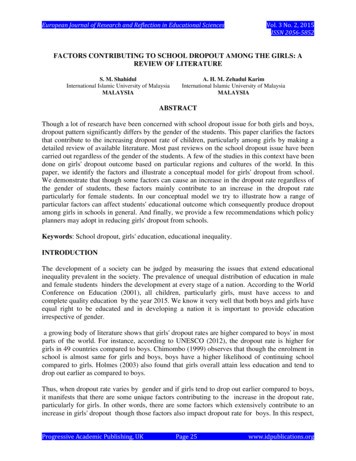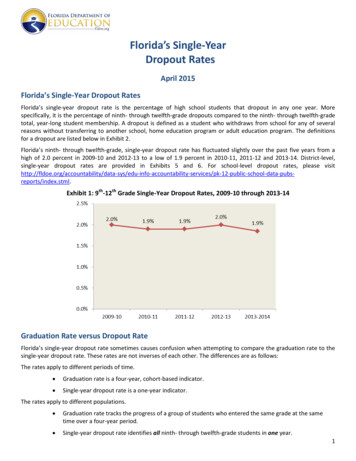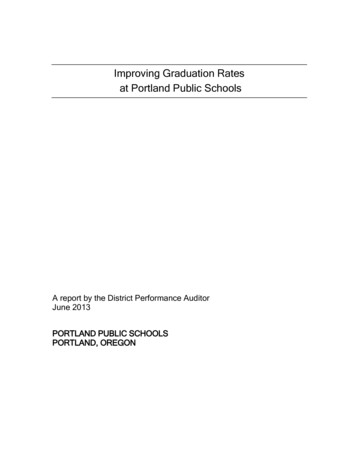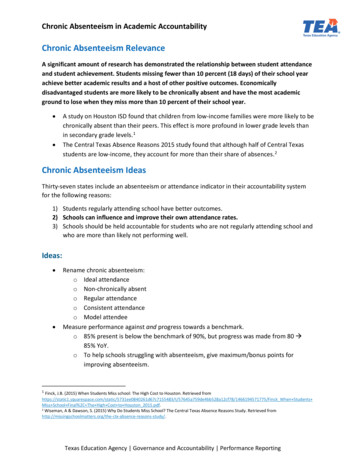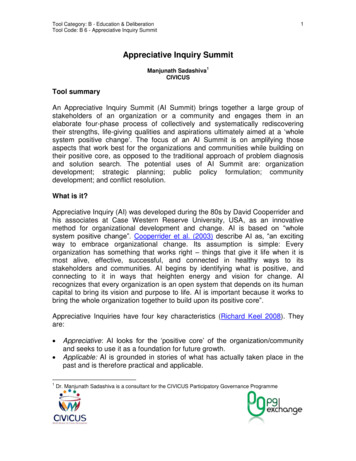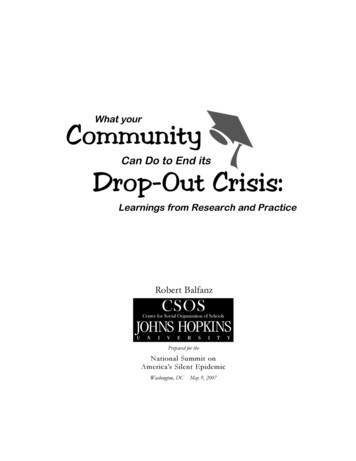
Transcription
Readers Note: This paper is based on over a decade’s worth of learning at the Center forSocial Organization of Schools at Johns Hopkins University. As such it draws upon thework of Jim McPartland, Doug MacIver, Joyce Epstein, Barbara Wasik, Nettie Legters,Allen Ruby, Martha MacIver, Ruth Neild, and Steve Sheldon, as well as theimplementation teams of the Talent Development Middle and High School Models. Anyerror is my own. Since this is written as a practical guide I have departed from standardacademic citation procedures and have instead provided web links to additionalresources. I would be happy to supply full citations to any one who wants them. I can becontacted at rbalfanz@csos.jhu.edu. An electronic version of the paper can be found atwww.gradgap.org.
A Call to ActionMany communities in the United States face a silent epidemic-year after year,one third to half or more of the primarily low-income and minority students they educatein their public school systems fail to graduate from high school(www.civicenterprises.net) Decades ago, this would not have been a crisis. Factory jobsprovided an avenue for employment and upward mobility for young adults without highschool degrees. Today, the unemployment rate for young adults without a high schooldiploma is staggering. As a result, failure to graduate from high school has become aticket to the underclass. For a single individual this can be tragic, but when the majorityor near majority of students from entire neighborhoods and communities fail to graduate,the social and economic costs are profound and far reaching.It does not have to be this way. We know enough about who dropouts are, why theydrop out and how to prevent it to help communities confront and stop their dropout crisis.Over a decade’s worth of research, development and direct action confronting thedropout crisis indicates that, while it will not be easy, quick or cost-free, this is a crisisthat can alleviated by a combination of effort and policy (www.all4ed.org, www.jff.org).Moreover, it is worth doing. Pick your issue – improving the economic vitality of yourcommunity, cutting its crime rate, reducing its social welfare costs, expanding its middleclass, reducing concentrated poverty, or achieving social justice - stopping the dropoutcrisis in your community is a means to achieve it.The following is offered as roadmap or practical advice on how to begin. Likeall advice it should be taken with a grain of salt. Each community is different and I canonly report on what I have read and learned, so this knowledge and experience must beintegrated with local facts and the characteristics of each community. The advice is basedon what is known at the national level about the nature of the dropout crisis and how itcan be prevented (www.gradgap.org), experience over the past decade working withmiddle and high schools that serve low-income students in more than 30 communities toimplement the Talent Development Middle and High School whole school reform models(www.csos.jhu.edu ) , and operation of the Baltimore Talent Development High School,an Innovation High School in the heart of one of the highest poverty neighborhoods inAmerica (www.btdhs.org) .A Three Step Plan for Ending the Dropout Crisis in Your CommunityThere are three essential steps to ending the dropout crisis in our communities.First, your community needs to understand its dropout crisis and the resources it iscurrently devoting to ending it. Second, your community needs to develop a strategicdropout prevention, intervention and recovery plan that focuses community resources,efforts and reforms at the key points where and when students fall off the path to highschool graduation. Finally, your community will need to gather the human and financialresources needed for a comprehensive and sustained campaign and develop theevaluation, accountability and continuous improvement mechanisms needed to maintainit.1
Step 1-Understand the Dropout Crisis in Your CommunityWho Drops Out in our Community?The most basic questions that need to be answered are how many students dropout, how far from graduation are they when they drop out (what percent of dropouts arerelatively close to graduation-within a year or so and what percent are far away –still inneed of three to four years of secondary schooling) and from which schools do they dropout? There is an almost dizzying array of dropout statistics available but the one youneed is what percent of students who enter ninth grade (or the first year of high school)for the first time graduate on time, as well as one or two years after their expectedgraduation date.These questions need to be approached in two ways. The community and schooldistrict should invest the time and resources necessary to retrospectively trace the path ofseveral groups of students as they progress through the school district from the sixthgrade to graduation or dropping out. This is the best way for the community to get a firmunderstanding of how far students are from graduation when they drop out. It also showsfactors that can predict who will drop out and will provide a baseline from which to judgethe impact of reforms. Nearly all school districts have the data needed to do this, butdepending on how the data is organized it can be a labor-intensive process. So in manycases it may be necessary to involve university researchers or provide the school districtwith additional funding to hire the necessary personnel. In the end, though, this analysiswill require only modest investments in time and dollars and bring large dividends.Recently Boston, New York and Philadelphia have undertaken these efforts and can serveas good models and resources for other communities (http://www.projectuturn.net).In the meantime, communities can launch their efforts to end the dropout crisis byusing readily available data to produce reasonable estimates of the extent and location oftheir dropout crisis. The data provided by the EPE Research Center provides estimates ofthe graduation rate in each school district in the United States(http://www2.edweek.org/rc/index.html). It also shows at which points in the high schoolyears students are being lost. Data available at the Alliance for Excellence in Educationwebsite (www.all4ed.org) allows communities to go one step further and pinpoint thehigh schools with the highest and lowest graduation rates. Finally, estimates on how farhigh school dropouts are from graduation can be gleaned by examining a random sampleof the high school transcripts of students who have stopped attending high school in thecurrent year. These estimates will be sufficient to help launch community efforts, but it isessential for long-term success that the more complete data analysis be done.2
Why do Students in our Community Dropout?Knowing how many students are dropping out, how far from graduation they are, andfrom which schools they are dropping out is only the first piece of knowledge needed. Itis also essential to gain an understanding of the source of the dropout crisis in yourcommunity. Research and experience indicates that there are four broad classes ofdropouts.1) Life events- students who dropout because of something that happens outside ofschool -- they become pregnant, get arrested or have to go to work to supportmembers of their family.2) Fade Outs-students who have generally been promoted on time from grade tograde and may even have above grade level skills but at some point becomefrustrated or bored and stop seeing the reason for coming to school. Once theyreach the legal dropout age they leave, convinced that they can find their waywithout a high school diploma or that a GED will serve them just as well.3) Push Outs-students who are or are perceived to be difficult, dangerous ordetrimental to the success of the school and are subtly or not so subtly encouragedto withdraw from the school, transfer to another school or are simply droppedfrom the rolls if they fail too many courses or miss too many days of school andare past (or in some cases not even past) the legal dropout age.4) Failing to Succeed- students who fail to succeed in school and attend schools thatfail to provide them with the environments and supports they need to succeed.For some, initial failure is the result of poor academic preparation, for others it isrooted in unmet social-emotional needs. Few students drop out after their initialexperience with school failure. In fact, most persist for years, only dropping outafter they fall so far behind that success seems impossible or they are worn downby repeated failure. In the meantime, they are literally waving their hands saying“help” through poor attendance, acting out and/or course failure.Communities need a good estimate of how much of their dropout crisis is driven byeach type of dropout, as each requires substantially different prevention, intervention andrecovery actions. In my experience, the popular viewpoint is that “life events,” “fadeouts” and “push outs” predominate, when in fact “failing to succeed” students often arethe main source of dropouts. But because each community is different, it is important toget a clear sense of the relative magnitude of each type of dropout. This can be done witha survey, some interviews and a more detailed version of the group analysis.One way to get a sense of the forces propelling students out of school is to ask highschool students to report the reasons they are absent. By and large this year’s dropout islast year’s truant, so asking students to report the number of school days they miss forvarious reasons provides insight into why students drop out. We have learned that when3
the survey is anonymous students do not hesitate to provide answers even when they donot cast themselves in the best light. The survey results can then be used for follow-upinterviews with a sub-set of students to delve more deeply into motives for dropping out.Surveys and interviews provide important context, but without a careful analysis thatfollows groups of students forward from sixth grade and examines the attendancepatterns, behavioral history (suspensions etc.), course grades, credit history and testscores of students who graduate and dropout, you can not truly understand the source ofdropouts in your community. As importantly, the analysis enables you to develop “ontrack” and “off-track” indicators that are critical in establishing an effective dropoutprevention and intervention strategy. Good advice on how to do this can be found in anarticle by Craig Jerald on developing early indicator tentialDropouts.pdf).Once again, however, it is not necessary for this analysis to be completed before acommunity can begin to end its dropout crisis. This work can begin based on findingsfrom other districts and then be refined as specific community details emerge. Work inChicago, New York and Philadelphia has shown that both the majority of students whowill drop out and who will graduate can be identified long before this occurs. Moreover,the critical indicators are based on data readily available in, and commonly collected by,schools and school districts.Our own work in Philadelphia, which has been replicated in three other urbandistricts, shows that about half of eventual dropouts can be identified by the end of sixthgrade, and close to 75% by the start of high school. In short, we have found that middlegrade students who fail their courses, attend school less then 85-90% of the time and areseen as having behavioral problems either via suspensions or poor behavior or effortmarks seldom graduate. Work in Chicago has shown that the same is true for studentswho receive more than one F in a single ninth-grade marking df). These are the “failing to succeed”students. Through their course failure, poor attendance and behavioral problems they arein essence asking for help. But because our educational systems are not organized torecognize and respond to these early indicators of falling off the graduation track, “failingto succeed” students are too often ignored until it is too late.Are Our Schools Organized to Reduce Dropouts or Do They Inadvertently Help CreateThem?The last question communities need to ask themselves about their dropout crisis iswhether their schools are making it better or worse. The community needs to examineclosely all the high schools from which the majority of students are dropping out and themiddle schools that feed them. It needs to take a hard look at three tough issues.4
First, are these schools over-challenged and under-resourced? For example, insome high-poverty non-selective neighborhood high schools there can be 400 or morestudents in the ninth grade with more than 80% of them either repeating for the second orthird time, overage for grade, in special education, two or more years below grade levelin mathematics and reading and/or having missed a month or more of eighth grade. Inthis case, only 1 in 5 students can be described as the typical student high schools weredesigned to educate -- students who are first time ninth-graders, on age, come to schoolregularly, are not in special education, and have math and reading skills on the seventhgrade level or higher. Four out of five students need substantial and sustained supports inorder to succeed at all, let alone in a high-standards, high-stakes testing environment. Asimilar situation can be found in the sixth grade of a high-poverty middle school. Hereyou can have 25 sixth-graders with attendance problems, a different 25 with behaviorproblems and an additional 50 students failing either math or English, with each groupneeding different levels of different interventions (www.gradgap.org).The high degree of educational challenge is only half the story. Far too often thishuge challenge is met with an under-resourced response. Ninth grade, for example, istypically viewed as the least desirable teaching assignment in a high school, so moreexperienced and often more-skilled teachers end up teaching the upper grades and theninth grade is taught by a shifting constellation of new, inexperienced, emergencycertified teachers and long-term subs. High-poverty middle grades schools are likewise,viewed as an undesirable teaching assignment with teachers leaving for either elementaryor high schools at the first opportunity. As the Education Trust Funding Gaps 2006 reportshows, these imbalances in experience and skill lead to both poor academic outcomes andgreat funding inequities across schools within districts (www.edtrust.org). So some of thetough questions a community needs to ask are “who is teaching the ninth grade in thehigh schools with the highest dropout rates” and “who is teaching in the middle schoolsthat feed them” and “how does their skill, experience level, and stability compare toteachers in more successful schools in the district?” The community then needs to takeanother one step further and calculate the actual dollars being spent on instruction andstudent support in each school.The third set of hard questions communities need to ask about their schoolsrevolves around school climate and teaching and learning conditions. High schools withhigh dropout rates and the middle schools that feed students into them are often markedby high rates of teacher and administrator turnover and absences. This has multiplenegative consequences. It is impossible to have meaningful and lasting reform if theteachers and administrators who need to carry it out are constantly shifting. High staffturnover also means that students are taught by high numbers of inexperienced teachers,provisionally certified teachers and long-term subs. Sometimes they can be taught by noone at all while administrators desperately search for a live body to put in front of theclass. When many teachers are frequently absent it leads to the other adults in thebuilding having to cover their classes, and in so doing, takes away the time and energythey have to do their jobs or lead reform efforts.5
Communities need to look at teacher and administrator turnover rates andabsences and attempt to understand their cause. Look for two things. First, a chaoticschool climate with students milling in the halls long after the bell has rung and all theclassroom doors shut tight. Talk to teachers, administrators and students. If the teacherssay that the administration does not back them up when students act out; if administratorssay teachers are not doing their job with classroom management; if students say they findsome teachers caring, but others capricious and unfair, then you have likely found aschool where teacher-administrator and teacher-student relationships have broken down.Everyone is blaming someone else and the collaboration and trust that is essential tosuccessful school reform are non-existent (or only exist among a small beleaguered groupof teachers/administrators). This creates a feeling that all teachers must fend forthemselves as best they can. It leads some to conclude that the only thing they can do isleave as soon as possible and/or take off as many days as they can to make it through theyear.There is also a second more subtle school climate to be on the lookout for: theschool that appears more or less orderly but where everything moves at a languid pace.Examine student lateness and attendance. Are many students straggling in 30 minutes oreven an hour or more late? Do many classrooms appear just to have a handful of studentsin them?The other type of ruinous school climate that can emerge is one in which lowexpectations dominate. The school is implicitly organized to do the minimum possible toget through the day without a major incident. Students know as long as they do not actout, not much is expected of them and they can pass without doing much work and comeand go as they please. This environment, though less overtly stressful than a chaoticschool, is similarly unappealing to many teachers who then leave as soon as they can.In sum, the last piece of understanding the dimensions, location andcharacteristics of the dropout crisis in a community is to hold the high schools with highdropout rates and the middle schools that feed them up to a mirror. Has the communityorganized its public education system so a sub-set of its secondary schools face an almostoverwhelming level of educational challenge? Has it further responded not by providingthese schools with additional resources, but in fact by providing them fewer resourceswhen teacher quality and the actual educational dollars spent at each secondary schoolare examined? Is it allowing these schools to continue year after year with dysfunctionalschool climates that are either chaotic or organized around low expectations and as aresult witness a high rate of teacher and administrator turnover and absences? In short,has it created dropout factories?6
Understanding the Dropout Crises in Your DistrictQuestionsWho Drops Out?1. How many dropouts?2. When do theydropout?3. How far are they fromgraduating?MethodUse retrospective data toanswer these questions forpast cohortsLook at the current state ofdropping out in thecommunityWhy Do Students Drop Out?Determine the reasons:1. Life events2. Fade outs3. Push outs4. Failure to SucceedAre Schools Organized toReduce or Create Dropouts?1. Are schools overchallenged?2. Are schools underresourced?3. How great is turnover?4. How is schoolclimate?Survey, school observationand data analysis.TechniquesTrack how past cohorts of students movingthrough middle and high school have donea. Identify when students dropped out –how far from graduationb. Develop dropout predictorsc. Create a dropout baselineExamine existing data gathered by otherorganizations.a. Education Week Resource Center:graduation rates in each district and byrace and genderb. Alliance for Education in Education:identify high schools with lowestgraduation rateReview high school transcripts to determine atwhat point students drop out – how far fromgraduation.Anonymously survey truant studentsFollow-up interviews for more detailed dataUse past cohort data to identify on-track vs. offtrackgraduation indicators.Use already existing indicators based onretrospectivestudies done in similar districts.Challenges: Identify number and percent ofa. Repeat 9th gradersb. Overage for gradec. Special educationd. 2 or more years below grade in Englishor mathe. Absent for more than a monthResources: Identifya. If least experienced teach 9th and middlegradesb. Actual dollars spent per student in eachschoolTurnover: Determinea. Administrator turnover ratesb. Teacher turnover ratesc. Teacher absence ratesd. Teacher certification typese. Use of long-term substitutesClimate:a. Chaotic climate1) Students in hallways instead of class, rowdybehavior with little attempt to foster betterbehavior2) Teacher-administration conflict/fingerpointing rather than cooperation3) Teachers feel isolated and on their own4) Students not feel teachers careb. Low expectations climate1) School orderly but little teaching andlearning7
2)3)Classes start late, students straggle inSmall numbers in each classStep 2-Combine the Basics of Good Schooling with Focused Prevention,Intervention, and Recovery Efforts at the Key Points where StudentsFall off the Path to GraduationIn order to stop the dropout crisis communities need to work to insure that twothings occur in their schools. First, that all students receive the basics of goodschooling—engaging, meaningful ,and challenging curriculum and instruction, deliveredby well- trained and supported teachers, in serious and safe schools designed to providestudents with the personalized attention they need to succeed in a high-standardslearning environment. Communities, however, also need to realize that for schools inhigh-poverty neighborhoods this will not be enough. On top of the basics of goodschooling a comprehensive dropout prevention, intervention and recovery system needsto be put in place and efforts need to be focused at the key points where students fall offthe path to graduation.Simply put, if students successfully make transitions into each level of schooling(elementary, middle, and high), they are significantly more likely to graduate from highschool. Existing evidence shows that effective reforms at each of these transition pointscan increase graduation rates by about 10 percentage points. This, in turn, indicates thatattention needs to be paid to all of them, as well as the transition to post-secondaryschooling. Focused efforts at any one transition point, can make a difference, but existingresearch and experience tell us that it will not be enough to fundamentally end acommunity’s dropout crisis. Existing research and experience also tell us that this will notbe easy, but this does not mean it can not be done. Central to success will be viewingthese efforts not as school reform but as a community campaign to end the dropout crisis.But how can a community lead a campaign to reform its schools to end thedropout crisis? It can do so by making sure that reforms with records of success are inplace at each transition and existing policies that evidence indicates are counterproductive to keeping students on the graduation track are abandoned and modified.What follows is a simplified road map for each of the key transitions wherestudents fall off the graduation path. This is meant to be illustrative, not definitive. Itsgoal is to provide one view on where and on what a community can focus its attention.For each transition there will be a key focus, some do’s and some do not’s.You will notice an overriding theme. At each key transition point communitiesneed to pay attention to insuring that all students have the academic/cognitive skills,social-emotional supports and behavioral expectations they need to succeed in each levelof schooling. This is because most students who dropout do so for a combination ofacademic and social-emotional reasons. And it recognizes that even the best instruction inthe world will have limited impact if students do not attend school on a regular basis, tryto succeed and behave.8
The Transition into Elementary SchoolThe primary goal at this level is to insure that all students have a successful start.This has three aspects. Students need to acquire the cognitive skills and knowledge thatwill let them successfully learn in school. They also need to be socialized into the normsand behaviors of schooling. The tricky part is that this has to be done in a joyful manner.What is this saying? Our system of education in which a single adult instructs20 to 30 students only functions if students are prepared to succeed in this type oflearning situation. Students who are not prepared to succeed in it fall behind andultimately dropout. If a student does not have the cognitive skills or knowledge tounderstand and successfully integrate the lesson a teacher is giving or know how tobehave according to the expectations of the classroom, they will not learn at the expectedrate. As a result, they will become frustrated, and just as significantly frustrate the adultsin the school building. This in turn will lead to a number of often counter-productiveresponses including yelling at students, grade retention and special education placement.The importance of a successful start is well recognized. What is too oftenoverlooked, however, is that a successful start involves more than just skills andsocialization. It involves instilling in students that learning is a joyful experience andschools can be a place of joy. Why is this important to preventing dropouts? It’simportant because if students’ first experience with schooling is that it is a place oftension, rules, and constraint but no joy, they will view it as something to be endured notcherished. The question then becomes, why endure? Without strong countervailingpressure from their parents or peers that schooling may not be engaging but it’snecessary, some students will be on the path to dropping out from the very start.Every Student a Successful Early ReaderNothing is more essential to success in school than being able to read well.Communities must insure that everything humanly possible and then some is done toinsure that all students are both reading at appropriate levels by second grade and are ontrack to make a successful transition to the more complex reading skills needed for theupper elementary pload/report pdf.pdf).How is this done? First, make sure that high quality pre-k programs are availablefor all who need or want them. Second, establish a series of reading benchmarks. Whenstudents do not meet these benchmarks, have a tiered response with increased intensity ofinstruction until success is achieved. In other words, keep decreasing the student-teacherratio, varying instructional techniques and/or increasing the time spent on instructionuntil the struggling child has learned to read well. Ultimately some children will needone-on-one instruction to learn how to read and those who need it must be provided thissupport. The upfront cost will be repaid through fewer grade retentions and specialeducation placements. But effective one-on-one instruction can be difficult for school9
systems to organize and sustain, so it should be reserved for the students who absolutelyneed it. This means that intermediate responses between traditional reading groups andone-on-one instruction will also be needed. One possibility to keep in mind is familyliteracy programs in which parents are taught how to play an active role in developingtheir children’s reading skills. A struggling early reader may have younger siblings whocan benefit as well (http://www.famlit.org). This can be an area in which communitygroups can play a critical role.Socialize Students into the Norms of Schooling in a Joyful MannerStudents who live in high-poverty environments can experience high levels ofuncertainty and stress in their lives. This can cause young students to either withdraw oract out. School must be an antidote to this. Young students need to see that learning isexciting and that school is a place where they are cared for. They need to feel secure. Atthe same time they need to be successfully socialized into the expected norms of activityand behavior in schools-everything from raising hands to taking turns to working quietly.What this means in practical terms is that the early years of schooling need to befull of singing and dancing, art activities, and science projects-experiences that enablestudents to experience success, the joy of learning and provide them important contentknowledge about the world. At the same time class size reduction needs to be usedstrategically and combined with positive behavior supports and evidence-basedinterventions like the good behavior game to create the conditions needed for all studentsto successfully learn the behavioral norms of u might ask what class size has to do with behavior. Quite a bit as it turns out.While it is often assumed that reduced class size leads to more student attention anddifferent instructional approaches (which it can), some evidence suggests that one of thekey reasons class size reduction seems to have a bigger impact in the early grades relatesto behavior. Think of it this way. We routinely instruction hundreds of college students ata time in large lecture halls but we would never think of educating hundreds of preschool students like this. Why? Because they would not behave in a productive manner.Even if by some magic we could keep them all quiet, they still would not focus on thelecture and take notes. Students need to be taught the behaviors of school and if classesare large in the early years this becom
Recently Boston, New York and Philadelphia have undertaken these efforts and can serve . transfer to another school or are simply dropped . credit history and test scores of students who graduate and dropout, you can not truly understand the source of dropouts in your community. As importantly, the analysis enables you to develop "on-

